

Jesse Peltan
@JessePeltan
On a mission to build Type 1 Civilization and restore the biosphere
631 Following 55.1K Followers
People are starting to realize that China’s massive buildout of solar photovoltaics has nothing to do with climate change, and everything to do with tapping the resource that makes up >99.9% of Earth’s energy budget.
Show more
0
0
40
203
35
Depopulation is not salvation.
100,000 humans are entirely capable of ecological mass destruction — as history has already shown.
We do not help life by becoming small.
We help life by becoming wise. https://t.co/6e8JA2qNeP
Show more

0
0
8
62
3
Solar has a much higher power density than people seem to believe.
Photovoltaics are more power dense than New York City.
0
0
74
323
54
People keep saying that "batteries are bad" because:
"batteries don't create energy. batteries consume energy."
Nothing. Creates. Energy.
Energy is neither created nor destroyed.
"Energy production" and "energy consumption" are economic terms — not physics terms.
We don't actually produce or consume energy.
We direct energy.
The function of a battery is not upstream energy harvesting, but that's also not the function of a thermal generator.
The energy doesn't come from the generator.
The energy comes from the fuel.
We have to extract, refine, and transport that fuel. The generator is there to dispatch that chemical potential energy as electricity when it's needed.
That's what batteries do too, because:
Batteries ARE generators.
Batteries aren't electromechanical generators, but neither are photovoltaics or fuel cells.
Like chemical-fueled thermal generators, batteries convert chemical potential energy into electrical energy. The difference with batteries is that the process has fewer steps and is easily reversible.
Batteries provide a buffer, matching up supply and demand in time. They act as a cache, providing higher peak power at lower latency than a thermal generator of comparable mass or cost.
Batteries are an extremely useful tool for directing the flow of energy.
Batteries don't "create energy" — that's true.
Nothing. Creates. Energy.
Show more
0
0
386
2.5K
521
China's electricity per capita is up 569%
Ours is down 7%
Yeah we've had some energy efficiency gains and that's great, but we need more electricity.
We should be building industrial capacity and electrifying our economy. https://t.co/JlEq1YZm4K
Show more
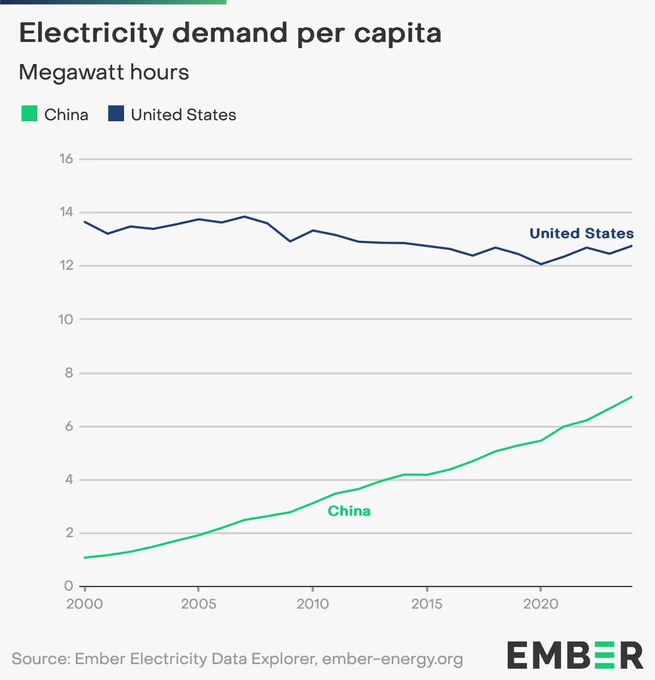
0
0
15
249
36
If "too much solar" is what's keeping us from growing,
how was China able to grow 7.5x since 2000? https://t.co/GS0MjB2hpC

0
0
11
61
9
Last year, China’s electricity demand grew by more than one Germany
…or every data center on Earth combined. https://t.co/PvVA9MpUCV
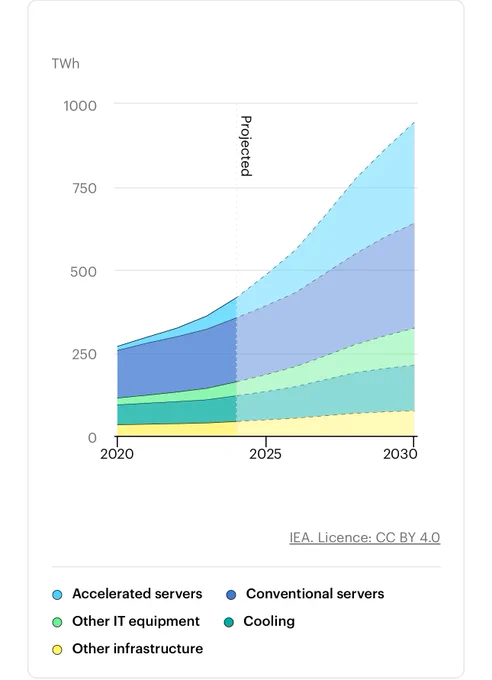
0
0
7
155
23
I keep seeing a misconception that transmission lines are made out of copper.
For the vast majority of lines (especially overhead), that's not the case.
Most power lines are made from a steel core wrapped with aluminum conductors.
(that's why power lines look silvery and not coppery)
Steel provides the strength, and aluminum provides the conductivity.
(they both provide some of each but that's primarily how it works)
But isn't copper more conductive than aluminum?
For the same cross sectional area, aluminum is only about 60% as conductive as copper, but it's also only 30% as dense as copper.
For the same mass of metal, aluminum is about twice as conductive as copper.
Copper is better when you're space constrained (like in an electric motor), but aluminum is better when you're weight constrained.
Aluminum isn't just a cost saving measure (although it does cost 1/4th as much per kg). For a lot of applications, aluminum is actually better than copper.
Show more

0
0
38
597
67
China didn’t build all this solar for the purpose of lowering emissions.
They’re tapping the largest energy resource on Earth.
Emissions reductions are a side effect. https://t.co/DjAd4jc69p

0
0
13
87
10
I see this misinterpreted all the time.
Elon is not literally proposing that we build a single giant solar farm to power the whole country.
It’s an illustration.
“what about all the transmission you’d need!??”
You’re missing the point entirely. Solar PV has a higher power density than New York City.
We don’t need to build massive transmission to use solar. In fact, one of the biggest advantages of solar PV is that solar energy is already wirelessly distributed.
Solar is one of the few technologies that can actually cut distribution costs. No centralized generator, even an SMR, is going to help with the distribution costs that make up 2/3 of T&D.
Solar + storage lets us bypass T&D constraints and generate electricity on site.
With how slow T&D upgrades have been, solar + storage is essential for rapid electrification at scale.
Show more
0
0
33
280
33
Either humanity reaches Type 1, or all known life goes extinct.
Earth is 4.5 billion years old.
Life on Earth is 3.7 billion years old.
In just ~0.5 billion years, the Sun’s growing luminosity will destroy the carbon cycle, and with it all complex life.
In ~1 billion years, it will boil the oceans and sterilize the planet entirely.
Life on Earth is in its final hours, doomed to the hellfire of an expanding Sun. Humanity is the only hope.
We can engineer Earth's climate and extend its lifespan by billions of years.
The Sun's expansion however, is unyielding. Eventually, we must shepherd life beyond the confines of its cradle.
There is no contradiction between the flourishing of humanity and the flourishing of the biosphere.
Our fates are one and the same.
Show more

0
0
730
2.8K
488
We could regreen the Sahara by covering less than 0.5% of it in solar panels and desalinating water.
Grassland precipitation - 0.7 meters/year
Solar irradiance (GHI) - 6 kWh/m^2/day
PV efficiency - 23%
Desalination efficiency - 3 kWh/m^3
(2.1 kWh/m^2/year)
Show more
0
0
266
1.2K
193
For most of human existence, we had only 100 watts per person - enough food to fuel metabolism.
Fire and animal labor expanded our power supply to a few hundred watts per person.
Today, the average American has ~10,000 W at their disposal - a 100x increase.
A 100x increase in power may seem just as unimaginable to us today as it would have to our ancestors, but in retrospect we can hardly imagine how people ever lived without the abundance we enjoy today.
Our descendants will feel a similar sense of bewilderment as they look back on us.
Show more

0
0
113
801
164
Lots of people are saying transmitting electricity is "inefficient."
Total transmission and distribution (T&D) losses are less than 5%.
The cost of T&D is NOT LOSSES - it’s capacity.
We have to pay the same amount to build and maintain that capacity - regardless of how much we use it.
Load (demand) side storage can charge when there’s excess T&D capacity, and discharge when it’s constrained.
Batteries improve load factor, which means we can transmit more watt hours through each watt of capacity.
Batteries are one of our most powerful tools to rapidly increase grid capacity and lower costs.
Show more
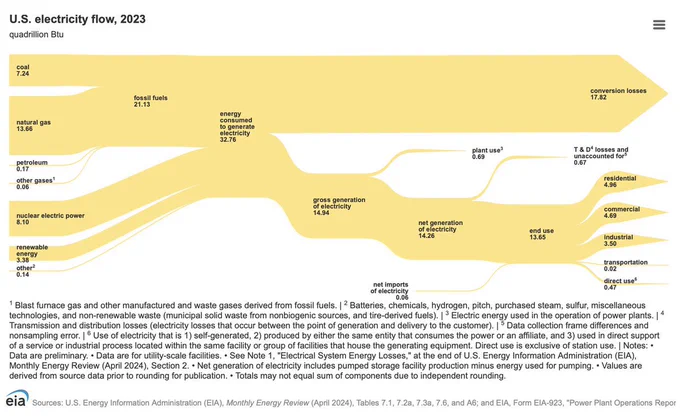
0
0
13
184
30
There is NO COBALT in a lithium iron phosphate battery (LFP).
LFP is the chemistry currently being deployed at scale for grid storage.
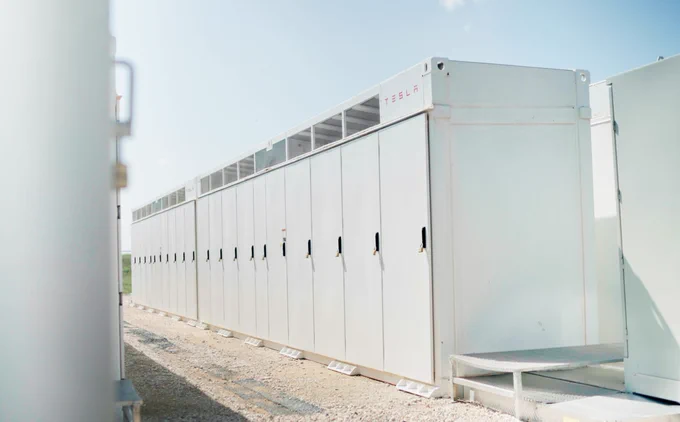
0
0
7
62
4
People keep missing this.
GDP is NOT FIXED
GDP = Joules * GDP/Joule
Increasing our energy supply and using that energy more efficiently makes the world wealthier.
0
0
14
125
22
Comments are full of people in the little red circle,
telling the people in the big red circle,
that solar doesn't work,
because of winter... https://t.co/nJgpOJ15Wd
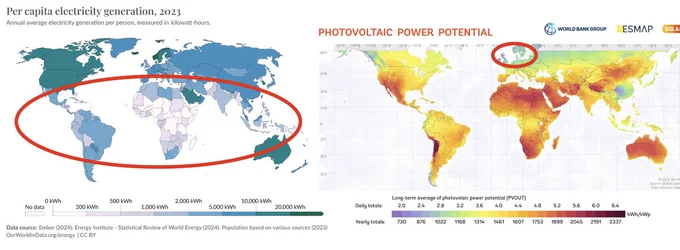
0
0
11
108
12
1 solar panel per person can lift the world out of energy poverty.
10 panels per person can bring the world to U.S. levels.
That's not personal electricity consumption.
That's all consumption - industry included.
Show more

0
0
10
57
11
We absolutely should invest in nuclear fission, but even quadrupling our fission capacity is tiny compared to the growth already happening in solar.
300 GW of new nuclear over 25 years is 12 GW/year.
China built 278 GW of solar - last year.
12 GW of new nuclear every year would barely match current U.S. solar growth (50 GW DC in 2024), let alone growth by 2050, and it's completely dwarfed by the current rate of Chinese solar growth.
Solar is out-accelerating everything else.
Any nation that doesn't embrace it will be left behind.
Show more
0
0
189
566
102
If China's 888 GW of installed solar operated at U.S. capacity factors, it would generate 44% of U.S. electricity.
We have a massive irradiance advantage, especially compared to Southeastern China.
The U.S. should dominate in solar, but we are getting absolutely smoked.
Even with poorer solar resources, China generates 3x as much electricity from solar. China's solar generation now exceeds U.S. nuclear.
(and exceeds Chinese nuclear by a factor of 2)
Show more

0
0
23
250
47














